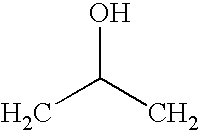Shape memory epoxy copolymer
a polymer and shape memory technology, applied in the field of manufacturing of epoxy based shape memory polymers, can solve the problems of inability to activate materials, inability of polymers to efficiently make use of rigid phases, and materials that have not yet been widely used
- Summary
- Abstract
- Description
- Claims
- Application Information
AI Technical Summary
Benefits of technology
Problems solved by technology
Method used
Image
Examples
example 1
[0038]As an example, 1.08 g aniline (amine reagent) was mixed with 0.066 g of methylenedianiline (crosslinking diamine). The resulting solution was mixed with 4.17 g of bisphenol A diglycidyl ether to form an homogeneous solution. This solution was then injected into a glass mold, made with two, 2″×2″ glass with a Viton O-ring sandwiched in between, by syringe. The resulting material was cured in an oven pre-heated to 125 C for 18 hours. This resulted in a clear solid shape memory polymer at room temperature that has a glass transition temperature (Tg) of about 104 C. The resulting material was also tough, as revealed by its resistance to cutting by razor blade hitting with a hammer, and with large elongation above its Tg, and excellent shape recovery. The rubbery modulus of this material was also significantly higher than the styrene-based SMP.
example 2
[0039]For a resin system with a Tg of 103° C., Bisphenol A diglycidyl ether at 78.94% weight is mixed with aniline at 19.88% weight and DETDA (major isomers: 3,5-diethyltoluene-2,4-diamine and 3,5-diethyltoluene-2,6-diamine) at 1.19% weight. All components are miscible liquids and are easily combined through mechanical mixing.
example 3
[0040]For a resin system with a Tg of 60° C., diglycidyl ether of Bisphenol A at 45.32% weight and 1,4-butanediol diglycidyl ether at 31.38% weight are mixed with aniline at 21.99% weight and DETDA (major isomers: 3,5-diethyltoluene-2,4-diamine and 3,5-diethyltoluene-2,6-diamine) at 1.31% weight. All components are miscible liquids and are easily combined through mechanical mixing.
[0041]While the amount of crosslinking reagents used can vary from 0.01 mol % to 10 mol % or more, it is particularly preferred to keep the amount between 0.2 mol % to 7.0 mol %. The amount of phenol or amine reagents will vary stoichiometrically with the epoxide reagents and each can vary from 35 mol % to 65 mol %. It is particularly preferred that both are in the range of 45 mol % to 55 mol %.
[0042]The glass transition temperature of the shape memory polymer can be also be tailored by altering the mixture of mono- and multi-functional amine reagents and the multifunctional epoxy resins. The transition te...
PUM
| Property | Measurement | Unit |
|---|---|---|
| glass transition temperature | aaaaa | aaaaa |
| temperature | aaaaa | aaaaa |
| temperature | aaaaa | aaaaa |
Abstract
Description
Claims
Application Information
 Login to View More
Login to View More - R&D
- Intellectual Property
- Life Sciences
- Materials
- Tech Scout
- Unparalleled Data Quality
- Higher Quality Content
- 60% Fewer Hallucinations
Browse by: Latest US Patents, China's latest patents, Technical Efficacy Thesaurus, Application Domain, Technology Topic, Popular Technical Reports.
© 2025 PatSnap. All rights reserved.Legal|Privacy policy|Modern Slavery Act Transparency Statement|Sitemap|About US| Contact US: help@patsnap.com



